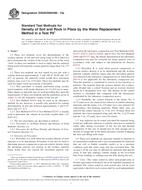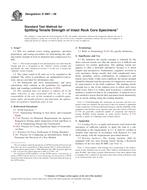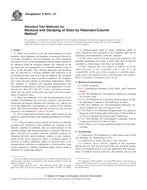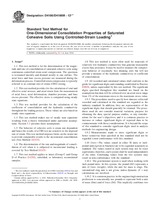Potřebujeme váš souhlas k využití jednotlivých dat, aby se vám mimo jiné mohly ukazovat informace týkající se vašich zájmů. Souhlas udělíte kliknutím na tlačítko „OK“.
ASTM D5030/D5030M-13a
Standard Test Methods for Density of Soil and Rock in Place by the Water Replacement Method in a Test Pit (Includes all amendments And changes 6/7/2021).
Automaticky přeložený název:
Standardní zkušební metody pro Hustota zemin a hornin v místě metodou reprodukční Voda v testu Pit
NORMA vydána dne 15.11.2013
Informace o normě:
Označení normy: ASTM D5030/D5030M-13a
Poznámka: NEPLATNÁ
Datum vydání normy: 15.11.2013
Kód zboží: NS-29575
Počet stran: 14
Přibližná hmotnost: 42 g (0.09 liber)
Země: Americká technická norma
Kategorie: Technické normy ASTM
Kategorie - podobné normy:
Zemní práce. Hloubicí práce. Budování základů. Podzemní práce
Anotace textu normy ASTM D5030/D5030M-13a :
Keywords:
acceptance tests, degrees of compaction, densities, density tests, field tests, in-place densities, pit tests, quality controls, test pit densities, water pits, water replacement methods, ICS Number Code 93.020 (Earth works. Excavations. Foundation construction. Underground works)
Doplňující informace
| Significance and Use | ||||||||||||||||||||||||||||||||||||||||
|
5.1 These test methods are used to determine the in-place density of compacted materials in construction of earth embankments, road fills, and structure backfill. For construction control, the test methods can be used as the basis for acceptance of material compacted to a specified density or to a percentage of a maximum density determined by a standard laboratory test method such as determined from Test Methods D698 or D1557, subject to the limitations discussed in 5.2 These test methods can be used to determine in-place density of natural soil deposits, aggregates, soil mixtures, or other similar material. 1.1 These test methods cover the
determination of the in-place density of soil and rock using water
to fill a lined test pit to determine the volume of the test pit.
The use of the word “rock” in these test methods is used to imply
that the material being tested will typically contain particles
larger than 3 in. [75 mm].
1.2 These test methods are best suited for test pits with a volume between approximately 3 and 100 ft3 [0.08 and 2.83 m3]. In general, the materials tested would have maximum particle sizes over 5 in. [125 mm]. These test methods may be used for larger sized excavations if desirable. 1.2.1 This procedure is usually performed using circular metal templates with inside diameters of 3 ft [0.9 m] or more. Other shapes or materials may be used providing they meet the requirements of these test methods and the guidelines given in 1.2.2 Test Method D4914 may be used as an alternative method. Its use, however, is usually only practical for volume determination of test pits between approximately 1 and 6 ft3 [0.03 and 0.17 m3]. 1.2.3 Test Method D1556 or Test Method D2167 is usually used to determine the volume of test holes smaller than 1 ft3 [0.03 m3]. 1.3 The two procedures are described as follows: 1.3.1 Procedure A—In-Place Density and Density of Total Material (Section 12). 1.3.2 Procedure B—In-Place Density and Density of Control Fraction (Section 13). 1.4 Selection of Procedure: 1.4.1 Procedure A is used when the in-place density of total material is to be determined. Procedure A can also be used to determine percent compaction or percent relative density when the maximum particle size present in the in-place material being tested does not exceed the maximum particle size allowed in the laboratory compaction test (Test Methods D698, D1557, D4253, D4254, D4564, and D7382). For Test Methods D698 and D1557 only, the density determined in the laboratory compaction test may be corrected for larger particle sizes in accordance with, and subject to the limitations of, Practice D4718. 1.4.2 Procedure B is used when percent compaction or percent relative density is to be determined and the in-place material contains particles larger than the maximum particle size allowed in the laboratory compaction test or when Practice D4718 is not applicable for the laboratory compaction test. Then the material is considered to consist of two fractions, or portions. The material from the in-place density test is physically divided into a control fraction and an oversize fraction based on a designated sieve size. The density of the control fraction is calculated and compared with the density(ies) established by the laboratory compaction test(s). 1.4.3 Normally, the control fraction is the minus No. 4 [4.75-mm] sieve size material for cohesive or nonfree-draining materials and the minus 3-in. [75-mm] sieve size material for cohesionless, free-draining materials. While other sizes are used for the control fraction 3/8 , 3/4-in. [9.5, 19-mm], these test methods have been prepared using only the No. 4 [4.75-mm] and the 3-in. [75-mm] sieve sizes for clarity. 1.5 Any material can be tested, provided the material being tested has sufficient cohesion or particle attraction to maintain stable sides during excavation of the test pit and through completion of this test. It should also be firm enough not to deform or slough due to the minor pressures exerted in digging the hole and filling with water. 1.6 These test methods are generally limited to material in an unsaturated condition and is not recommended for materials that are soft or friable (crumble easily) or in a moisture condition such that water seeps into the excavated hole. The accuracy of the test may be affected for materials that deform easily or that may undergo volume change in the excavated hole from standing or walking near the hole during the test. 1.7 Units—The values stated in either inch-pound units or SI units [presented in brackets] are to be regarded separately as standard. The values stated in each system may not be exact equivalents; therefore each system shall be used independently of the other. Combining values from the two systems may result in non-conformance with the standard. 1.7.1 The gravitational system of inch-pound units is used when dealing with inch-pound units. In this system, the pound (lbf) represents a unit of force (weight), while the unit for mass is slugs. The slug unit is not given, unless dynamic (F = ma) calculations are involved. 1.7.2 In the engineering profession, it is customary practice to use, interchangeably, units representing both mass and force, unless dynamic calculations (F = Ma) are involved. This implicitly combines two separate systems of units, that is, the absolute system and the gravimetric system. It is scientifically undesirable to combine the use of two separate systems within a single standard. These test methods have been written using inch-pound units (gravimetric system) where the pound (lbf) represents a unit of force (weight); however, conversions are given in the SI system. The use of balances or scales recording pounds of mass (lbm), or the recording of density in lbm/ft3 should not be regarded as nonconformance with this standard. 1.8 All observed and calculated values shall conform to the guidelines for significant digits and rounding established in Practice D6026. 1.8.1 The procedures used to specify how data are collected, recorded or calculated in this standard are regarded as the industry standard. In addition they are representative of the significant digits that generally should be retained. The procedures used do not consider material variation, purpose for obtaining the data, special purpose studies, or any considerations for the user’s objectives; it is common practice to increase or reduce significant digits of reported data to be commensurate with these considerations. It is beyond the scope of this standard to consider significant digits used in analytical methods for engineering design. 1.9 This standard does not
purport to address all of the safety concerns, if any, associated
with its use. It is the responsibility of the user of this standard
to establish appropriate safety and health practices and determine
the applicability of regulatory limitations prior to use.
Standard Test Method for Density (Unit
Weight), Yield, and Air Content (Gravimetric) of Concrete Standard Test Method for Total Evaporable
Moisture Content of Aggregate by Drying Standard Test Methods for Laboratory
Compaction Characteristics of Soil Using Standard Effort (12,400
ft-lbf/ft3 (600 kN-m/m3)) Standard Test Methods for Laboratory
Compaction Characteristics of Soil Using Modified Effort (56,000
ft-lbf/ft3 (2,700 kN-m/m3)) Standard Test Methods for Laboratory
Determination of Water (Moisture) Content of Soil and Rock by
Mass Standard Test Method for Relative Density
(Specific Gravity) and Absorption of Coarse Aggregate (Withdrawn
2024) Standard Terminology Relating to Soil,
Rock, and Contained Fluids Standard Test Method for Density and Unit
Weight of Soil in Place by the Sand-Cone Method Standard Test Method for Density and Unit
Weight of Soil in Place by the Rubber Balloon Method (Withdrawn
2024) Standard Practice for Minimum
Requirements for Agencies Engaged in Testing and/or Inspection of
Soil and Rock as Used in Engineering Design and Construction Standard Test Methods for Maximum Index
Density and Unit Weight of Soils Using a Vibratory Table (Includes
all amendments and changes 11/21/2019). Standard Test Methods for Minimum Index
Density and Unit Weight of Soils and Calculation of Relative
Density Standard Specification for Temperature
Monitoring Equipment Standard Test Methods for Determination
of Maximum Dry Unit Weight of Granular Soils Using a Vibrating
Hammer Standard Test Methods for Density and
Unit Weight of Soil and Rock in Place by the Sand Replacement
Method in a Test Pit Standard Specification for Woven Wire
Test Sieve Cloth and Test Sieves Standard Test Method for Density and Unit
Weight of Soil in Place by the Sleeve Method Standard Practice for Correction of Unit
Weight and Water Content for Soils Containing Oversize
Particles Standard Guide for Evaluating, Selecting,
and Specifying Balances and Standard Masses for Use in Soil, Rock,
and Construction Materials Testing Standard Practice for Using Significant
Digits and Data Records in Geotechnical Data |
Podobné normy:
Historická
1.7.2008
Historická
1.9.2007
Historická
1.11.2012
Historická
1.9.2007
Historická
1.1.2008
Historická
1.2.2014



 ASTM D3967-08
ASTM D3967-08 ASTM D4015-07
ASTM D4015-07 ASTM D4186/D4186M-12..
ASTM D4186/D4186M-12.. ASTM D421-85(2007)..
ASTM D421-85(2007).. ASTM D4219-08
ASTM D4219-08 ASTM D4220/D4220M-14..
ASTM D4220/D4220M-14..
 Cookies
Cookies
